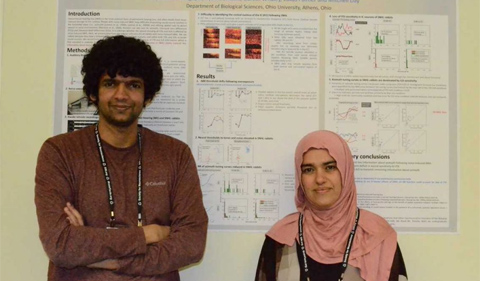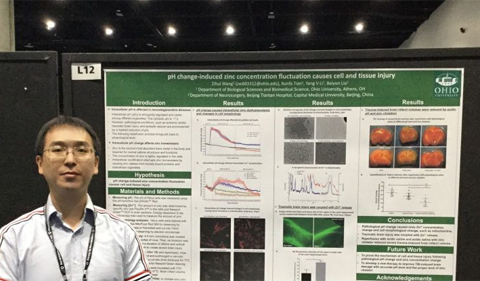Hariprakash Haragopal, a doctoral student in Dr. Mitchell Day’s lab, Sazan Ismael, a doctoral student in Dr. Daewoo Lee‘s lab, and Zihui Wang, a doctoral student in Dr. Yang Li’s lab, presented their research at the Annual Society for Neuroscience conference in San Diego in early November 2018.
Haragopal uses rabbits to study the effect of hearing loss on the processing of sound source location at the level of the mid-brain.
“Fundamentally, any sound source placed at a certain location will generate sounds which arrive earlier and are heard louder at the ear closer to the sound source than at the other ear, producing a time difference and a level difference between the two ears,” Haragopal said. “But, people with hearing loss have trouble utilizing these cues to pinpoint the direction of sound sources, and it is perceptually debilitating, because they are unable to use spatial separation between the speech and noise sources to pick the speech elements from noise.”
The preliminary findings suggest that the processing of time difference cue is severely compromised and that the nervous system relies mostly on the level difference cue to process the location of sound. Day’s lab is hopeful their results could potentially help create better hearing aids that can boost sound location cues in the hearing-impaired.
Ismael uses fruit flies in her study to model the most common neurodegenerative disorder, Alzheimer’s Disease. In this project, she is interested in looking at human tau release and how this release is regulated using Drosophila neuronal culture.
To learn more about her work, see Students Use Fruit Flies to Study Molecular Basis of Alzheimer’s Disease.
Wang’s research is about the cell and tissue injury caused by brain trauma-induced pH change. Brain pH is changed in brain trauma, and following reperfusion brain pH is brought back to normal. During this pH change, zinc ion will be released causing cell and tissue injury. It is important to study this because it will provide a novel therapeutic strategy to prevent reperfusion-induced brain injury, hopefully limiting injury to the brain after stroke.
In addition to research, Ismael said conferences like SfN offer many different types of opportunities such as networking and adventure. One of the most rewarding parts was attending the Arab Neuroscientists Social. She said despite the fact that she is not Arab, she was warmly welcomed by the group.
“Although the main goal in going to a big conference like SfN where you are facing thousands of neuroscientists across the world is to benefit our research, I learned more about networking,” Ismael said. “Especially, I met a group of neuroscientists from the Middle East, which was a golden chance for me since they have more in common with me. Their workshop gave me more ideas about where to go next and how to achieve it.”
On the top of science, Ismael said she enjoyed the beauty of San Diego, especially tide pools in the Cabrillo National Monument, Coronado Island and the La Jolla area.
“Viewing the Pacific Ocean and closely looking at seals were terrific!” she said. “As graduate students in science, you do not have much flexibility to travel and explore nature, but conferences allow us to.”





















Comments